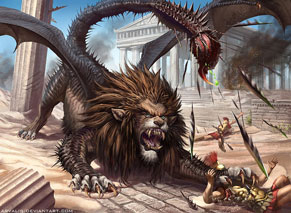By Alan McCoy from Dungeons & Dragons: Fundamentals
How to build challenging encounters against a Manticore
Note: This has been prepared utilizing only the 5E Core Rules. The Manticore can be found in the Monster Manual page 213.
The Manticore is a monster in every sense of the word, a vaguely humanoid head, the body of a lion and the wings of a dragon. A bristling mane stretches down its back and its long tail ends in a cluster of deadly spikes.
A Manticore isn’t particularly bright but does possess the ability to converse in the common tongue. Usually it doesn’t engage in conversation, mainly it denigrates or otherwise insults its foes. If the Manticore sees some advantage to keeping a foe alive, it is willing to do so, if provided with an appropriate tribute or sacrifice equal to the loss of the meal.
Manticores tend to be territorial, and do not take kindly to intrusion into their hunting ground by other predators, especially powerful ones.
Manticores are fierce killers that hunt far and wide for food, several can gather into a lion like pride and hunt cooperatively to bring down larger or exceptionally dangerous prey. Unfortunately for Adventurers, other Manticores are not the only creatures that these monsters form alliances with. They have been known to provide aerial support for a Hob army or to work as a mercenary for an Orc Horde.
Manticores are Lawful Evil.
Step 1) Let’s Review what we know about the Manticore
Exceptionally Strong and Tough, Highly Dexterous, Strong survival instinct, low intelligence and charisma.
Speed: 30 on the Ground, 50 in the Air.
Senses: Darkvision 60 Feet, Passive Perception 11.
Languages: Common.
Can Launch Tail Spikes up to 200 feet.
Can Multi-Attack: two claws and a bite or three tail spikes.
Manticores hunt with allies, either a pride of Manticores numbering three to five, or as aerial support for a ground force.
Step 2) Determine the probable Strategy.
Manticores are not animals motivated by hunting instinct in search of prey. While they are driven by their biological need to feed, they are also thinking creatures with a language and a belief system. (Alignment).
Because Manticores are lawful, once they have made a pact or alliance, they will honor that alliance unless they have good reason to break it. However, they are also evil, so they always intend to do as much harm as possible. When working with creatures that share their beliefs, they will be unfailingly loyal. When working as mercenaries, they will be less so.
Manticores favor Hobs (Hobgoblins) as allies and work very well with them.
Typical manticore strategy when working with a ground force is to turn the edges toward the center and keep the opponent caged in where the ground force can attack. This includes attacking enemy snipers and spellcasters first.
Typical manticore strategy when working with other manticores or alone is to isolate and separate one target from the group, gain some distance and attack that one at their leisure.
Manticores are somewhat cowardly and will avoid attacking creatures that obviously outclass or that can seriously injure it.
Step 3) Determine Tactics
Because they Manticore has Darkvision, it is comfortable hunting at night, and fully capable of supporting its primary ally, the Hob. As all predatory fliers however, it prefers the daylight, dusk and dawn are its preferred hunting hours. The range of Darkvision is too short to provide reaction time at speed.
The Manticore normally begins its attack while airborne, launching volley after volley of its tail spikes to soften up the targets to isolate and spread them out. The manticore knows that it has a limited number of tail spikes (24) available each day, so it uses them sparingly when it can.
If it sees an opportunity, the Manticore will pounce and grab an opponent and leap into the air, with its great strength it can carry up to 255 pounds without slowing, more than that slows it to half speed, more than 500 pounds means it can’t get airborne at all. It prefers to pounce on incapacitated prey. Once clear of the combat area, the incapacitated prey is dropped from altitude to ensure it is dead, then the Manticore will land and feed. (Start DASH->GRAB->End DASH)
Occasionally, the Manticore will take a still living opponent aloft, then drop it (Move -> Grapple-> Move). This usually results in a fall of twenty to thirty feet, though if there is a terrain feature available that will make the fall farther or more dangerous, it will be used.
When on the ground, the Manticore uses its claws and bite attacks. Like all flying creatures, it hates fighting on the ground.
The manticore prefers to focus its attacks on a single target, but if it sees something alarming, it can divide the attacks.
